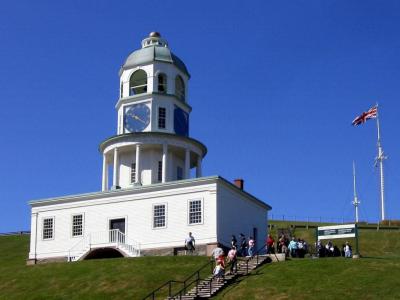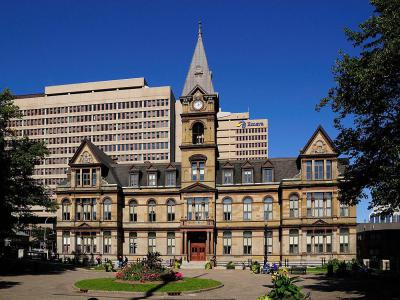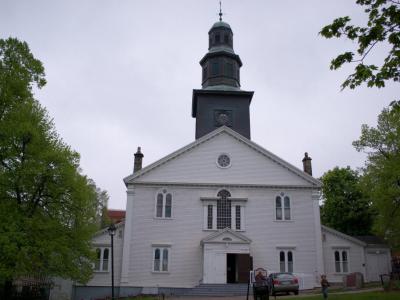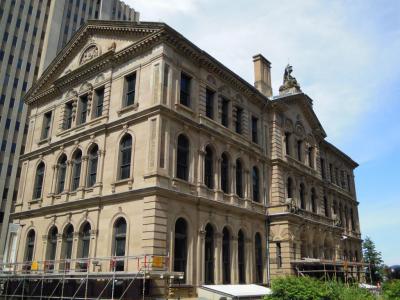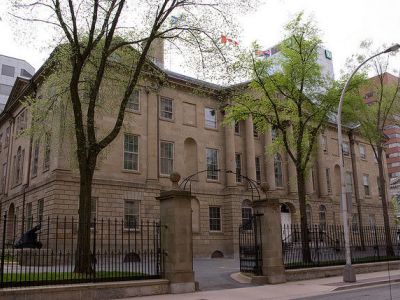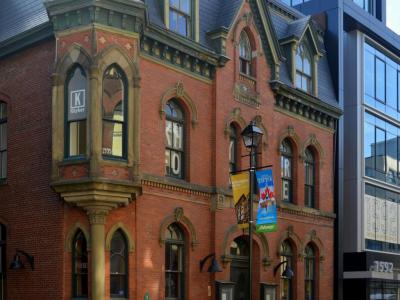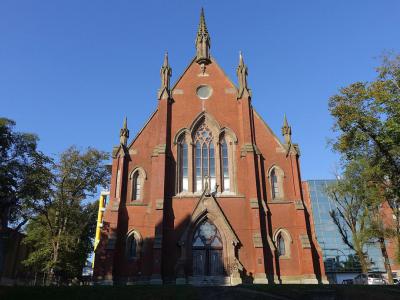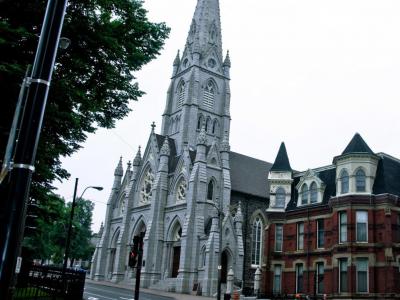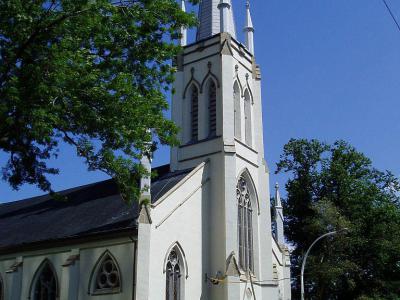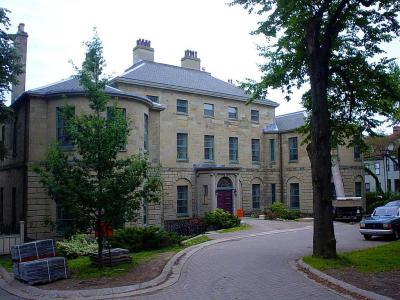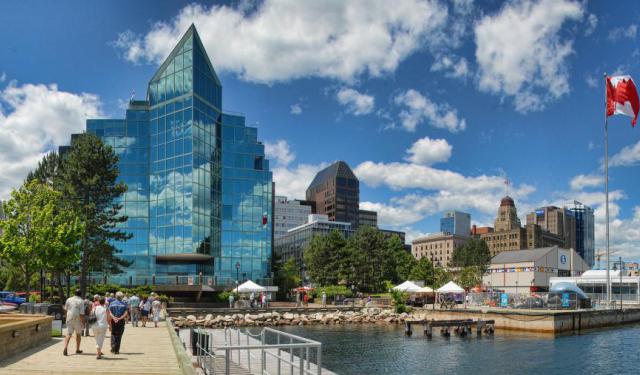Halifax Historical Buildings (Self Guided), Halifax
Between the impressive waterfront and colorful, bustling streets, Halifax is a picturesque city. Much of its fascinating history is duly reflected in the local architecture. There are a number of historical landmarks in Halifax, including the time-honored buildings, palaces, and churches, where you can learn much about its glorious past.
The presence of these historical locations is bound to make you want to go on a walk to soak up the scenery and dive into the rich history of the city. Here are some of the most important buildings not to miss:
Town Clock – arguably the most recognizable symbol of Halifax; completed in 1803 and commissioned by Prince Edward, Duke of Kent.
City Hall – notable for being one of the oldest public buildings in Nova Scotia, constructed in 1890.
Art Gallery of Nova Scotia – housed in the historic Dominion Building of 1865; home to over 14,000 works of art, ranging from Nova Scotian folk art to Inuit stone carvings.
Nova Scotia House of Assembly – the longest serving legislative building in Canada, as well as Canada's oldest house of government, operational since 1819.
Church of Saint David – much valued for its historical and spiritual association with Methodism and the creation of the United Church in Canada, as well as with the talented and renowned architect, David Stirling.
Government House of Nova Scotia – the official residence of the Lieutenant Governor of Nova Scotia, as well as that of the Canadian monarch.
If you set out to explore these and other interesting buildings in Halifax, with an in-depth historical information, we recommend that you take this self-guided walking tour for a truly wonderful trip!
The presence of these historical locations is bound to make you want to go on a walk to soak up the scenery and dive into the rich history of the city. Here are some of the most important buildings not to miss:
Town Clock – arguably the most recognizable symbol of Halifax; completed in 1803 and commissioned by Prince Edward, Duke of Kent.
City Hall – notable for being one of the oldest public buildings in Nova Scotia, constructed in 1890.
Art Gallery of Nova Scotia – housed in the historic Dominion Building of 1865; home to over 14,000 works of art, ranging from Nova Scotian folk art to Inuit stone carvings.
Nova Scotia House of Assembly – the longest serving legislative building in Canada, as well as Canada's oldest house of government, operational since 1819.
Church of Saint David – much valued for its historical and spiritual association with Methodism and the creation of the United Church in Canada, as well as with the talented and renowned architect, David Stirling.
Government House of Nova Scotia – the official residence of the Lieutenant Governor of Nova Scotia, as well as that of the Canadian monarch.
If you set out to explore these and other interesting buildings in Halifax, with an in-depth historical information, we recommend that you take this self-guided walking tour for a truly wonderful trip!
How it works: Download the app "GPSmyCity: Walks in 1K+ Cities" from Apple App Store or Google Play Store to your mobile phone or tablet. The app turns your mobile device into a personal tour guide and its built-in GPS navigation functions guide you from one tour stop to next. The app works offline, so no data plan is needed when traveling abroad.
Halifax Historical Buildings Map
Guide Name: Halifax Historical Buildings
Guide Location: Canada » Halifax (See other walking tours in Halifax)
Guide Type: Self-guided Walking Tour (Sightseeing)
# of Attractions: 10
Tour Duration: 1 Hour(s)
Travel Distance: 1.6 Km or 1 Miles
Author: Cathy
Sight(s) Featured in This Guide:
Guide Location: Canada » Halifax (See other walking tours in Halifax)
Guide Type: Self-guided Walking Tour (Sightseeing)
# of Attractions: 10
Tour Duration: 1 Hour(s)
Travel Distance: 1.6 Km or 1 Miles
Author: Cathy
Sight(s) Featured in This Guide:
- Town Clock
- City Hall
- Saint Paul's Church
- Art Gallery of Nova Scotia
- Nova Scotia House of Assembly
- Khyber Building
- Church of Saint David
- Saint Mary's Basilica
- Saint Matthew's United Church
- Government House of Nova Scotia
1) Town Clock
The Town Clock, also known as the Old Town Clock or the Citadel Clock Tower, is one of Halifax’s most recognizable landmarks, perched on the eastern slope of Citadel Hill overlooking Brunswick Street. This historic clock tower, a reconstruction of an early 19th-century Palladian-style structure, remains a symbol of the city’s military past and architectural heritage.
The idea for the Town Clock was conceived by Prince Edward, Duke of Kent, who served as the commander-in-chief of British North America’s military forces. Concerned about punctuality within the British Army and Royal Navy garrison in Halifax, he commissioned a turret clock before his return to England in 1800. The clock was manufactured by the prestigious House of Vulliamy, a renowned London-based firm of Royal Clockmakers.
The Town Clock officially began keeping time for Halifax’s garrison on October 20, 1803 and continues to function with its original mechanism-an intricate system of three weights, gears, and a 13-foot pendulum housed in a cast-iron frame. The bell chimes every quarter-hour and hour, maintaining the discipline of timekeeping established over two centuries ago.
The clock tower is a three-tiered octagonal structure, sitting atop a one-story rectangular white clapboard base that adheres to Palladian proportions. The building’s symmetrical design features classic elements such as a round-plan colonnade, supporting the octagonal clock level, which in turn gives way to an arcaded upper story, crowned with a copper dome, balustrade, and a decorative copper ball.
The clock face, set on all four sides, features Roman numerals, with “4” traditionally written as “IIII” rather than “IV” for aesthetic balance. The clock’s slow-moving mechanism has contributed to its longevity, requiring twice-weekly manual winding by employees of Citadel Hill National Historic Site, under the care of Parks Canada.
A Halifax icon, the Town Clock has appeared in various artworks, literature, and television, including the children’s show Theodore Tugboat, where it was personified as Chimey. As a historic timekeeper, it continues to bridge Halifax’s past and present, standing as a testament to its craftsmanship and enduring legacy.
The idea for the Town Clock was conceived by Prince Edward, Duke of Kent, who served as the commander-in-chief of British North America’s military forces. Concerned about punctuality within the British Army and Royal Navy garrison in Halifax, he commissioned a turret clock before his return to England in 1800. The clock was manufactured by the prestigious House of Vulliamy, a renowned London-based firm of Royal Clockmakers.
The Town Clock officially began keeping time for Halifax’s garrison on October 20, 1803 and continues to function with its original mechanism-an intricate system of three weights, gears, and a 13-foot pendulum housed in a cast-iron frame. The bell chimes every quarter-hour and hour, maintaining the discipline of timekeeping established over two centuries ago.
The clock tower is a three-tiered octagonal structure, sitting atop a one-story rectangular white clapboard base that adheres to Palladian proportions. The building’s symmetrical design features classic elements such as a round-plan colonnade, supporting the octagonal clock level, which in turn gives way to an arcaded upper story, crowned with a copper dome, balustrade, and a decorative copper ball.
The clock face, set on all four sides, features Roman numerals, with “4” traditionally written as “IIII” rather than “IV” for aesthetic balance. The clock’s slow-moving mechanism has contributed to its longevity, requiring twice-weekly manual winding by employees of Citadel Hill National Historic Site, under the care of Parks Canada.
A Halifax icon, the Town Clock has appeared in various artworks, literature, and television, including the children’s show Theodore Tugboat, where it was personified as Chimey. As a historic timekeeper, it continues to bridge Halifax’s past and present, standing as a testament to its craftsmanship and enduring legacy.
2) City Hall
Halifax City Hall was built in 1890. It was originally built to replace the old courthouse and for other public use. Halifax City Hall is notable for being one of the oldest public buildings in Nova Scotia. With four floors and a seven-story clock tower, it is also one of the largest.
The city hall was designed by architect Edward Elliot in the Late-Victorian Eclectic architecture style. The city hall building was built from the timbers of the demolished Dalhousie University, granite and sandstone laid in the freestone masonry technique.
The building underwent a major refurbishment in 2011. Most of the exterior stone was replaced along with the heating and cooling system and the elevator shaft. It was also wired for modern technology.
Visitors to Halifax will find the city hall conveniently located near many of the city's main attractions. It is a close walk to many historic sites, dining establishments, shopping boutiques and the harbor.
The city hall was designed by architect Edward Elliot in the Late-Victorian Eclectic architecture style. The city hall building was built from the timbers of the demolished Dalhousie University, granite and sandstone laid in the freestone masonry technique.
The building underwent a major refurbishment in 2011. Most of the exterior stone was replaced along with the heating and cooling system and the elevator shaft. It was also wired for modern technology.
Visitors to Halifax will find the city hall conveniently located near many of the city's main attractions. It is a close walk to many historic sites, dining establishments, shopping boutiques and the harbor.
3) Saint Paul's Church
Saint Paul’s Anglican Church, standing at the heart of Halifax’s Grand Parade, is more than just a house of worship-it’s a cornerstone of the city’s history. Built in 1750, this Georgian-style church is the oldest Anglican Church in North America and the oldest surviving building in Halifax. Its origins date back to the very founding of the city when town planners marked its central location in 1749. The church’s frame-an enduring combination of oak and pine-was precut in Boston and shipped north, ensuring its rapid assembly.
Architecturally, Saint Paul’s is a significant landmark as the first Palladian-style building in Canada. Designed by James Gibbs and modeled after London’s Saint Peter’s Church (circa 1728), it has undergone numerous expansions over the centuries. The church’s present structure includes wings added in the 19th century, making it one of the few Anglican churches worldwide with five aisles.
Beyond its architectural significance, Saint Paul’s has played a vital role in the development of Nova Scotia. Initially serving as the established church for the government and military, it became the cathedral church of the Diocese of Nova Scotia when Charles Inglis was appointed the first Bishop in 1787. The church was also the official place of worship for the garrison until 1844. Many notable figures have been associated with Saint Paul’s, including Governor Edward Cornwallis, Prince Edward (the future Duke of Kent), and several early political and military leaders, some of whom are buried beneath its floors.
The church has borne witness to Halifax’s most defining moments, hosting memorial services for the victims of the Titanic, the Halifax Explosion, and Swissair Flight 111. It remains a focal point for commemorations, royal jubilees, and state occasions, maintaining its legacy as a living, active parish. Recognized as a National Historic Site, Saint Paul’s continues to welcome visitors daily, standing as a testament to Halifax’s past and its enduring spiritual heritage.
Architecturally, Saint Paul’s is a significant landmark as the first Palladian-style building in Canada. Designed by James Gibbs and modeled after London’s Saint Peter’s Church (circa 1728), it has undergone numerous expansions over the centuries. The church’s present structure includes wings added in the 19th century, making it one of the few Anglican churches worldwide with five aisles.
Beyond its architectural significance, Saint Paul’s has played a vital role in the development of Nova Scotia. Initially serving as the established church for the government and military, it became the cathedral church of the Diocese of Nova Scotia when Charles Inglis was appointed the first Bishop in 1787. The church was also the official place of worship for the garrison until 1844. Many notable figures have been associated with Saint Paul’s, including Governor Edward Cornwallis, Prince Edward (the future Duke of Kent), and several early political and military leaders, some of whom are buried beneath its floors.
The church has borne witness to Halifax’s most defining moments, hosting memorial services for the victims of the Titanic, the Halifax Explosion, and Swissair Flight 111. It remains a focal point for commemorations, royal jubilees, and state occasions, maintaining its legacy as a living, active parish. Recognized as a National Historic Site, Saint Paul’s continues to welcome visitors daily, standing as a testament to Halifax’s past and its enduring spiritual heritage.
4) Art Gallery of Nova Scotia
The Art Gallery of Nova Scotia (AGNS) is the premier public provincial art museum in Halifax. Established in 1908 as the Nova Scotia Museum of Fine Arts, the institution adopted its current name in 1975. The museum’s main complex, located in downtown Halifax, spans approximately 6,200 square meters (67,000 square feet), incorporating the Dominion Building and two floors of the adjacent Provincial Building. The museum moved into the Dominion Building in 1988 and expanded its footprint a decade later in 1998.
AGNS holds a permanent collection of over 18,000 works, featuring pieces by Nova Scotian, Canadian, and international artists. The collection has been showcased in both Halifax and its Yarmouth satellite branch, which opened in 2006. However, the Yarmouth branch temporarily closed in January 2020 due to smoke damage before reopening in July 2021.
The museum began with 200 works from the Crown of Nova Scotia, moving between locations before settling in the 1867 Dominion Building, designed by David Stirling and William Hay. In 1998, it expanded, connecting to the Provincial Building via Ondaatje Court, which houses sculptures and an underground exhibition hall. This expansion also incorporated folk artist Maud Lewis’s home, now a major attraction.
AGNS houses the world's largest Maud Lewis collection, including 55 works and her restored home, acquired in 1996. In 2013, the Mintz family donated 2,070 Annie Leibovitz images, though copyright issues have restricted access to some.
Beyond photography and folk art, AGNS showcases works by First Nations artists, including Kent Monkman, whose large-scale painting Miss Chief's Wet Dream is a key highlight. The collection also includes works by renowned Nova Scotian artists Nancy Edell, Charlotte Lindgren, and Carol Fraser.
Today, AGNS remains a key institution in Nova Scotia’s cultural landscape, preserving and showcasing a diverse range of artistic expressions from historical to contemporary works.
AGNS holds a permanent collection of over 18,000 works, featuring pieces by Nova Scotian, Canadian, and international artists. The collection has been showcased in both Halifax and its Yarmouth satellite branch, which opened in 2006. However, the Yarmouth branch temporarily closed in January 2020 due to smoke damage before reopening in July 2021.
The museum began with 200 works from the Crown of Nova Scotia, moving between locations before settling in the 1867 Dominion Building, designed by David Stirling and William Hay. In 1998, it expanded, connecting to the Provincial Building via Ondaatje Court, which houses sculptures and an underground exhibition hall. This expansion also incorporated folk artist Maud Lewis’s home, now a major attraction.
AGNS houses the world's largest Maud Lewis collection, including 55 works and her restored home, acquired in 1996. In 2013, the Mintz family donated 2,070 Annie Leibovitz images, though copyright issues have restricted access to some.
Beyond photography and folk art, AGNS showcases works by First Nations artists, including Kent Monkman, whose large-scale painting Miss Chief's Wet Dream is a key highlight. The collection also includes works by renowned Nova Scotian artists Nancy Edell, Charlotte Lindgren, and Carol Fraser.
Today, AGNS remains a key institution in Nova Scotia’s cultural landscape, preserving and showcasing a diverse range of artistic expressions from historical to contemporary works.
5) Nova Scotia House of Assembly
The Nova Scotia House of Assembly meets within Province House, an architectural gem and the oldest legislative building in Canada. Opened in 1819, this historic landmark has witnessed over two centuries of governance, making it the longest-serving legislative building in the country. Designed in British Palladian style, the three-story structure is one of the finest examples of its kind in North America.
Built on the site of the former Governor’s House, originally constructed by Edward Cornwallis in 1749, the Province House initially housed the executive, legislative, and judicial functions of the colony under one roof. The Supreme Court of Nova Scotia once held its sessions in what is now the legislative library. The building also played a pivotal role in 1848, hosting the first instance of responsible government outside the United Kingdom within the British Empire.
Province House has been graced by the presence of royalty, dignitaries, and literary greats, including Charles Dickens, who described the Nova Scotia Legislature as resembling “Westminster through the wrong end of a telescope.” The building underwent major renovations between 1985 and 1994, with its reopening attended by Queen Elizabeth II. In 1996, it was designated a National Historic Site of Canada, recognizing its contributions to democratic governance and press freedom. Today, it remains the heart of Nova Scotia’s legislative process, a living testament to the province’s rich political history.
Built on the site of the former Governor’s House, originally constructed by Edward Cornwallis in 1749, the Province House initially housed the executive, legislative, and judicial functions of the colony under one roof. The Supreme Court of Nova Scotia once held its sessions in what is now the legislative library. The building also played a pivotal role in 1848, hosting the first instance of responsible government outside the United Kingdom within the British Empire.
Province House has been graced by the presence of royalty, dignitaries, and literary greats, including Charles Dickens, who described the Nova Scotia Legislature as resembling “Westminster through the wrong end of a telescope.” The building underwent major renovations between 1985 and 1994, with its reopening attended by Queen Elizabeth II. In 1996, it was designated a National Historic Site of Canada, recognizing its contributions to democratic governance and press freedom. Today, it remains the heart of Nova Scotia’s legislative process, a living testament to the province’s rich political history.
6) Khyber Building
Located on Barrington Street, the Khyber Building has been a cornerstone of Halifax’s cultural scene for over a century. Originally erected in 1888 as The Church of England Institute, this Victorian Gothic Revival structure was designed by architect Henry Busch, whose other works include the Halifax Academy and the Halifax Public Gardens Bandstand. Commissioned by Bishop Hibbert Binney, the building has evolved through various identities, from a religious institution to a vibrant artist-run center, music venue, and social space.
Its cultural reinvention began in 1994, when Halifax’s City Council repurposed the building as an arts hub, leading to the establishment of the Khyber Arts Society in 1997. By 1998, the Khyber Club emerged as a contemporary art gallery and performance space, fostering Halifax’s underground music and visual arts communities. Over the years, it became synonymous with artistic experimentation and creative energy, hosting countless exhibitions, concerts, and community events.
However, in 2014, the Halifax Regional Municipality closed the building due to hazardous materials, putting its future in limbo. A passionate movement emerged to reclaim and restore the space, and in March 2023, the Barrington Street Building Preservation Society secured $200,000 in federal funding and an additional $250,000 from the municipality to assist in remediation efforts. This funding marks a significant step toward reopening the Khyber as a thriving cultural venue under the stewardship of the Khyber Centre for the Arts.
Its cultural reinvention began in 1994, when Halifax’s City Council repurposed the building as an arts hub, leading to the establishment of the Khyber Arts Society in 1997. By 1998, the Khyber Club emerged as a contemporary art gallery and performance space, fostering Halifax’s underground music and visual arts communities. Over the years, it became synonymous with artistic experimentation and creative energy, hosting countless exhibitions, concerts, and community events.
However, in 2014, the Halifax Regional Municipality closed the building due to hazardous materials, putting its future in limbo. A passionate movement emerged to reclaim and restore the space, and in March 2023, the Barrington Street Building Preservation Society secured $200,000 in federal funding and an additional $250,000 from the municipality to assist in remediation efforts. This funding marks a significant step toward reopening the Khyber as a thriving cultural venue under the stewardship of the Khyber Centre for the Arts.
7) Church of Saint David
The Church of Saint David was born in 1925, when the Presbyterians leased and then purchased the former Grafton Street Methodist Church as their congregational home. The building stands atop a hill on Grafton Street, over and in the midst of the Old Methodist Burying Ground of Halifax, which is one of the most sacred sites of Maritime Methodism. Much valued for its historical and spiritual association with Methodism and the creation of the United Church in Canada, the place is also valued for its association with the talented and renowned architect, David Stirling.
Born in Scotland and immigrated to Canada about 1847, Stirling created many a building in Newfoundland, Nova Scotia and Ontario prior to designing the Grafton Street Church, in 1865. The latter was built in 1868-1869 (opened on November 7, 1869) on the site of an earlier, wooden church, erected in 1852 and burned down on February 23, 1868, leaving a small cemetery that still exists.
Designed in the Victorian Gothic (aka Early English or English College Chapel) style, Sterling's creation is a rare, if not unique, example of such architecture, constructed in brick in the province. It is more typical of Stirling's later Gothic-Revival style churches than his earlier ones; Grafton Street is the older of Stirling's two surviving Halifax churches.
The building is highlighted by its great front gable with tall Gothic buttresses and five detailed finials that project above the roof line. Most notably, the church was built without a steeple. Still, its front façade is quite striking and dominates the block.
Initially named simply the Presbyterian Church, the temple was renamed in 1930 in honor of the saintly King David I of Scotland, who reigned from 1124 to 1153.
Born in Scotland and immigrated to Canada about 1847, Stirling created many a building in Newfoundland, Nova Scotia and Ontario prior to designing the Grafton Street Church, in 1865. The latter was built in 1868-1869 (opened on November 7, 1869) on the site of an earlier, wooden church, erected in 1852 and burned down on February 23, 1868, leaving a small cemetery that still exists.
Designed in the Victorian Gothic (aka Early English or English College Chapel) style, Sterling's creation is a rare, if not unique, example of such architecture, constructed in brick in the province. It is more typical of Stirling's later Gothic-Revival style churches than his earlier ones; Grafton Street is the older of Stirling's two surviving Halifax churches.
The building is highlighted by its great front gable with tall Gothic buttresses and five detailed finials that project above the roof line. Most notably, the church was built without a steeple. Still, its front façade is quite striking and dominates the block.
Initially named simply the Presbyterian Church, the temple was renamed in 1930 in honor of the saintly King David I of Scotland, who reigned from 1124 to 1153.
8) Saint Mary's Basilica
Saint Mary's Cathedral Basilica is a Catholic cathedral in downtown Halifax. It is the largest Catholic church of the Archdiocese of Halifax. Though consecrated in 1899, it was made a basilica in 1950.
Construction of the original cathedral began in 1784 when laws forbidding Catholic worship in the region were repealed. The land was purchased and a wooden cathedral, then called Saint Peter's, was built. The current stone structure replaced the wooden building in 1820.
Saint Mary's was expanded in 1869. The facade was changed into a Norman-Gothic architectural style designed by Patrick Keely. This was when the spire was added to the building. Saint Mary's is noted for having the tallest granite spire in North America.
On 6 December 1917, a French cargo ship laden with high explosives, collided with the Norwegian vessel SS Imo outside of Halifax Harbor caused a massive explosion. The event is known as the Halifax Explosion. The interior of the cathedral suffered great damage during the explosion. Most of the cathedral's stained glass windows were shattered and some of the bells were cracked. Renovations have repaired the windows and restored the bells to their previous grandeur.
Saint Mary's is open during mass times to those who wish to take part in worship. Weekday masses take place from Monday through Friday at 12:15 PM. Sunday masses are at 8 AM, 10:30 AM and 5 PM.
Construction of the original cathedral began in 1784 when laws forbidding Catholic worship in the region were repealed. The land was purchased and a wooden cathedral, then called Saint Peter's, was built. The current stone structure replaced the wooden building in 1820.
Saint Mary's was expanded in 1869. The facade was changed into a Norman-Gothic architectural style designed by Patrick Keely. This was when the spire was added to the building. Saint Mary's is noted for having the tallest granite spire in North America.
On 6 December 1917, a French cargo ship laden with high explosives, collided with the Norwegian vessel SS Imo outside of Halifax Harbor caused a massive explosion. The event is known as the Halifax Explosion. The interior of the cathedral suffered great damage during the explosion. Most of the cathedral's stained glass windows were shattered and some of the bells were cracked. Renovations have repaired the windows and restored the bells to their previous grandeur.
Saint Mary's is open during mass times to those who wish to take part in worship. Weekday masses take place from Monday through Friday at 12:15 PM. Sunday masses are at 8 AM, 10:30 AM and 5 PM.
9) Saint Matthew's United Church
Saint Matthew’s United Church is a historic Protestant church located in downtown Halifax. Established in 1749, the same year as the original colony, it initially served as a place of worship for various dissenting Protestants from New England who did not align with the Church of England. The congregation originally gathered at Saint Paul’s Church until it secured its building at Hollis and Prince Streets in 1754. However, this structure was lost to a fire in 1857, leading to the construction of the current church on Barrington Street, on land from the Black-Binney House estate, provided by Bishop Hibbert Binney. The church also made use of the Old Burying Ground in Halifax.
From its early days, Saint Matthew’s was a mix of Scottish Presbyterians and Puritan Congregationalists from the American colonies. Over time, Presbyterians became the dominant group, leading to a shift toward Church of Scotland polity in 1787. By the 1830s, the church formally joined the Church of Scotland, later affiliating with the Presbyterian Church in Canada in 1875. However, with the formation of the United Church of Canada in 1925, Saint Matthew’s returned to a more inclusive Protestant tradition, reflecting its original diverse roots.
The church is notable for its historical connections to key figures. George Monro Grant, who served as Minister from 1863 to 1877, later became the Principal of Queen’s University in Kingston, Ontario. His legacy continued through his grandson, the philosopher George Parkin Grant, and his great-grandson, academic and politician Michael Ignatieff. During Grant’s tenure, the influential engineer and inventor Sandford Fleming-known for developing standard time zones-was also an Elder in the congregation.
Today, Saint Matthew’s United Church remains a landmark of Halifax’s religious and cultural heritage, reflecting the city’s deep Protestant traditions and its historical evolution within Canada’s diverse Christian landscape.
From its early days, Saint Matthew’s was a mix of Scottish Presbyterians and Puritan Congregationalists from the American colonies. Over time, Presbyterians became the dominant group, leading to a shift toward Church of Scotland polity in 1787. By the 1830s, the church formally joined the Church of Scotland, later affiliating with the Presbyterian Church in Canada in 1875. However, with the formation of the United Church of Canada in 1925, Saint Matthew’s returned to a more inclusive Protestant tradition, reflecting its original diverse roots.
The church is notable for its historical connections to key figures. George Monro Grant, who served as Minister from 1863 to 1877, later became the Principal of Queen’s University in Kingston, Ontario. His legacy continued through his grandson, the philosopher George Parkin Grant, and his great-grandson, academic and politician Michael Ignatieff. During Grant’s tenure, the influential engineer and inventor Sandford Fleming-known for developing standard time zones-was also an Elder in the congregation.
Today, Saint Matthew’s United Church remains a landmark of Halifax’s religious and cultural heritage, reflecting the city’s deep Protestant traditions and its historical evolution within Canada’s diverse Christian landscape.
10) Government House of Nova Scotia
The Government House of Nova Scotia, located on Barrington Street in Halifax, serves as the official residence of the lieutenant governor of Nova Scotia. Unlike many other provincial Government Houses in Canada, its prominent urban setting places it at the heart of the provincial capital while still being surrounded by gardens.
Construction of Government House was commissioned in 1800 by then-Governor Sir John Wentworth to replace the previous Government House, which stood on the site now occupied by Province House. The land had initially been designated for a new colonial legislature, but its location was ultimately deemed too distant from the capital. The cornerstone was laid on September 1, 1800, and although the building was still incomplete, the governor and his family moved in by 1805.
Over the years, Government House has hosted numerous royal guests. Prince Edward (later King Edward VII) was the first in 1860, followed by Prince Arthur (1869), Prince George (later King George V) in 1883 and 1901, and Prince Albert (1913). King George VI returned in 1939 with Queen Elizabeth, who later visited as the Queen Mother. Queen Elizabeth II made multiple visits. Other royals included Princess Margaret, Prince Andrew, Prince Edward, and Prince Charles with Princess Diana. The mansion also hosted finance ministers for the 1995 G7 summit in Halifax.
Government House, owned by the King in Right of Nova Scotia, hosts official functions, including Order of Nova Scotia investitures, receptions, and diplomatic events. It also serves as the site for swearing in the Executive Council, issuing election writs, and meetings with the premier. Periodically, it opens to the public.
Government House is a Georgian-style building with Adam influences, inspired by George Richardson’s 18th-century house plans. It was built using local stone, brick, and pine, with imported materials like London-made marble mantles. Designed for both entertainment and state affairs, it features a drawing room, dining room, ballroom, and private quarters. Portraits by Nova Scotian artist Robert Field enhance its historical significance.
Today, the Government House remains a cornerstone of Nova Scotia’s political and ceremonial life, symbolizing both the province’s colonial past and its ongoing role in Canadian governance.
Construction of Government House was commissioned in 1800 by then-Governor Sir John Wentworth to replace the previous Government House, which stood on the site now occupied by Province House. The land had initially been designated for a new colonial legislature, but its location was ultimately deemed too distant from the capital. The cornerstone was laid on September 1, 1800, and although the building was still incomplete, the governor and his family moved in by 1805.
Over the years, Government House has hosted numerous royal guests. Prince Edward (later King Edward VII) was the first in 1860, followed by Prince Arthur (1869), Prince George (later King George V) in 1883 and 1901, and Prince Albert (1913). King George VI returned in 1939 with Queen Elizabeth, who later visited as the Queen Mother. Queen Elizabeth II made multiple visits. Other royals included Princess Margaret, Prince Andrew, Prince Edward, and Prince Charles with Princess Diana. The mansion also hosted finance ministers for the 1995 G7 summit in Halifax.
Government House, owned by the King in Right of Nova Scotia, hosts official functions, including Order of Nova Scotia investitures, receptions, and diplomatic events. It also serves as the site for swearing in the Executive Council, issuing election writs, and meetings with the premier. Periodically, it opens to the public.
Government House is a Georgian-style building with Adam influences, inspired by George Richardson’s 18th-century house plans. It was built using local stone, brick, and pine, with imported materials like London-made marble mantles. Designed for both entertainment and state affairs, it features a drawing room, dining room, ballroom, and private quarters. Portraits by Nova Scotian artist Robert Field enhance its historical significance.
Today, the Government House remains a cornerstone of Nova Scotia’s political and ceremonial life, symbolizing both the province’s colonial past and its ongoing role in Canadian governance.
Walking Tours in Halifax, Canada
Create Your Own Walk in Halifax
Creating your own self-guided walk in Halifax is easy and fun. Choose the city attractions that you want to see and a walk route map will be created just for you. You can even set your hotel as the start point of the walk.
Halifax Introduction Walking Tour
Halifax is located on the ancestral lands of the Mi'kmaq who lived in the area long before Europeans arrived. Mi'kmaq called the area "Great Harbor". The city itself was established by the British in 1749 in violation of treaties with the Mi'kmaq. The establishment of the city led to Father le Loutre's War, otherwise known as the Anglo-Micmac War.
General Edward... view more
Tour Duration: 2 Hour(s)
Travel Distance: 2.9 Km or 1.8 Miles
General Edward... view more
Tour Duration: 2 Hour(s)
Travel Distance: 2.9 Km or 1.8 Miles
The Most Popular Cities
/ view all



